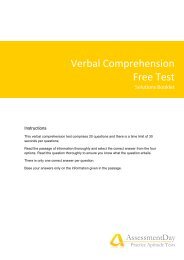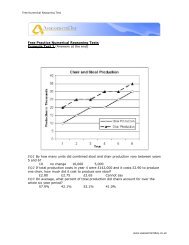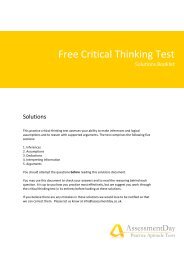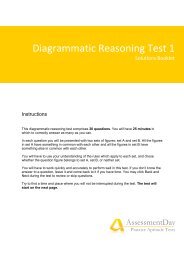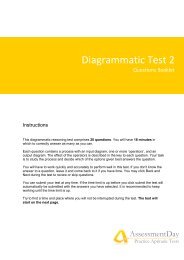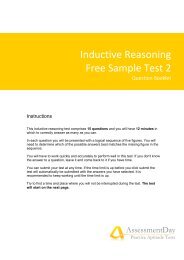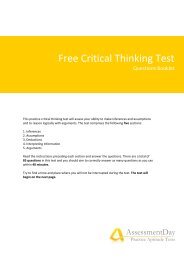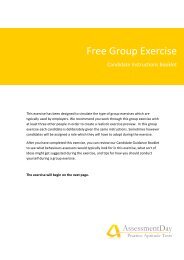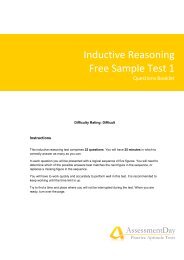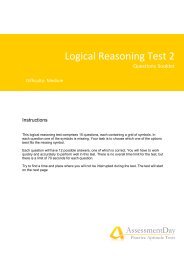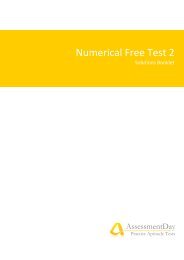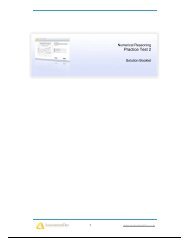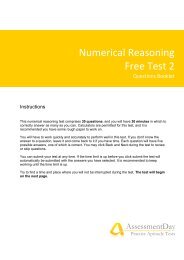Verbal Reasoning Test 1 Solutions (PDF) - Aptitude Test
Verbal Reasoning Test 1 Solutions (PDF) - Aptitude Test
Verbal Reasoning Test 1 Solutions (PDF) - Aptitude Test
Create successful ePaper yourself
Turn your PDF publications into a flip-book with our unique Google optimized e-Paper software.
<strong>Verbal</strong> <strong>Reasoning</strong><br />
Free <strong>Test</strong> 1<br />
<strong>Solutions</strong> Booklet<br />
Instructions<br />
This verbal reasoning test comprises 30 questions, and you will have 25 minutes in which to<br />
correctly answer as many as you can.<br />
You will be presented with a passage to read, and a statement about that passage. You<br />
must select one of the following answers:<br />
True: The statement follows logically from the information contained in the passage.<br />
False: The statement is logically false from the information contained in the passage.<br />
Cannot Say: It is not possible to determine whether the statement is true or false<br />
without further information.<br />
You will have to work quickly and accurately to perform well in this test. If you don’t know the<br />
answer to a question, leave it and come back to it if you have time.<br />
Try to find a time and place where you will not be interrupted during the test. The test will<br />
begin on the next page.<br />
Assessment Day<br />
Practice <strong>Aptitude</strong> <strong>Test</strong>s
Instituted in 1979 as a temporary measure to limit population growth, China’s<br />
one child policy remains in force today and is likely to continue for another decade.<br />
China’s population control policy has attracted criticism because of the manner in<br />
which it is enforced, and also because of its social repercussions. Supporters of the<br />
Chinese government’s policy consider it a necessary measure to curb extreme<br />
overpopulation, which has resulted in a reduction of an estimated 300 million people<br />
in its first twenty years. Not only is a reduced population environmentally beneficial, it<br />
also increases China’s per capita gross domestic product. The one-child policy has<br />
led to a disparate ratio of males to females – with abortion, abandonment and<br />
infanticide of female infants resulting from a cultural preference for sons. Furthermore,<br />
Draconian measures such as forced sterilization are strongly opposed by critics as a<br />
violation of human reproduction rights. The one-child policy is enforced strictly in<br />
urban areas, whereas in provincial regions fines are imposed on families with more<br />
than one child. There are also exceptions to the rules – for example, ethnic minorities.<br />
A rule also allows couples without siblings to have two children – a provision which<br />
applies to millions of sibling-free adults now of child-bearing age.<br />
Q1. China’s one-child policy increases the country’s wealth.<br />
True False Cannot say<br />
Cannot Say - The fourth sentence states that the policy increases China’s per capita gross<br />
domestic product, however this is just one economic indicator and is based on output per<br />
person. The passage does not tell us if overall, the country as a whole has increased wealth<br />
due to the one child policy. Since the passage does not tell us either way, we must respond<br />
Cannot Say.<br />
Q2. The passage suggests that two-child families will dramatically increase, as<br />
sibling-free adults reach child-bearing age.<br />
True False Cannot say<br />
False - The last sentence merely presents the fact that millions or sibling-free couples are<br />
able to have two children, and does not speculate as to the implications.<br />
You may share this document with others as long<br />
as you credit AssessmentDay.co.uk with a website<br />
link but you can’t change this document in any<br />
way or use its contents commercially.<br />
Page 2<br />
AssessmentDay<br />
www.assessmentday.co.uk<br />
Document last updated 05-07-2013
Q3. The main criticism of China’s one-child policy is that it violates human rights.<br />
True False Cannot say<br />
Cannot Say - The second sentence states that both the policy’s manner of enforcement and<br />
its social repercussions are criticised – but does not state which is the main criticism. So<br />
based on the information we are given, we cannot say.<br />
Q4. Families with more than one child are more common in China’s rural areas.<br />
True False Cannot say<br />
Cannot Say - While the 7th sentence states that the policy is enforced less strictly in<br />
provincial regions, comparative figures are not provided. One might deduce this statement is<br />
likely given what we are told, but we are not told explicitly if this is true or<br />
false, therefore we cannot say.<br />
Q5. The general preference among Chinese parents is for male babies.<br />
True False Cannot say<br />
True - The fifth sentence tells us that “a disparate ratio of males to females” is the result of “a<br />
cultural preference for sons”. Whilst it might be impossible to make assumptions about what<br />
each parent’s preference is, the key word in the statement in “general” which means we can<br />
look at the overall trend, in this case towards sons.<br />
You may share this document with others as long<br />
as you credit AssessmentDay.co.uk with a website<br />
link but you can’t change this document in any<br />
way or use its contents commercially.<br />
Page 3<br />
AssessmentDay<br />
www.assessmentday.co.uk<br />
Document last updated 05-07-2013
There are 562 federally recognized American Indian tribes, with a total of<br />
1.7 million members. Additionally, there are hundreds of groups seeking federal<br />
recognition – or sovereignty – though less than ten percent will successfully achieve<br />
this status. Federally recognised tribes have the right to self-government, and are also<br />
eligible for federal assistance programmes. Exempt from state and local jurisdiction,<br />
tribes may enforce their own laws, request tax breaks and control regulatory activities.<br />
There are however limitations to their sovereignty including, amongst others, the ability<br />
to make war and create currency. Historically, tribes were granted federal recognition<br />
through treaties or by executive order. Since 1978 however, this has been replaced by<br />
a lengthy and stringent regulatory process which requires tribes applying for federal<br />
recognition to fulfil seven criteria, such as anthropological and historical evidence. One<br />
of the complications regarding federal recognition is the legal definition of “Indian”.<br />
Previously, racial criteria, tribal records and personal affidavits were used to classify<br />
American Indians. Since the 1970s, however, there has been a shift to the use of a<br />
political definition – requiring membership in a federally recognized tribe in order to<br />
qualify for benefits, such as loans and educational grants. This definition, however,<br />
excludes many individuals of Native American heritage who are not tribal members.<br />
Q6. There are only two exemptions to a federally recognized tribe’s powers of selfgovernment.<br />
True False Cannot say<br />
False - The fifth sentence states that there are “limitations” and cites two “amongst others”.<br />
So we are told there are more than two limitations.<br />
Q7. Demand for federal recognition is high because it is a prerequisite for<br />
benefit programmes.<br />
True False Cannot say<br />
Cannot Say - The passage does not specify why hundreds of groups are seeking federal<br />
recognition. Even though one might postulate demand is due to receiving benefits, the<br />
passage does not tell us this is or is not the case, so we cannot say.<br />
You may share this document with others as long<br />
as you credit AssessmentDay.co.uk with a website<br />
link but you can’t change this document in any<br />
way or use its contents commercially.<br />
Page 4<br />
AssessmentDay<br />
www.assessmentday.co.uk<br />
Document last updated 05-07-2013
Q8. Since 1978 it has become harder for a tribe to achieve federally<br />
recognized status.<br />
True False Cannot say<br />
Cannot say – The 7th sentence refers to the introduction of a “lengthy and stringent<br />
regulatory process” in 1978 however the passage does not tell us how difficult it was before<br />
the introduction of this process. In order to respond either True or False we would need to<br />
know about before and after 1978 to draw a comparison, but we do not so we must respond<br />
Cannot say.<br />
Q9. Federally recognized tribes are not subject to state laws and do not pay<br />
taxes.<br />
True False Cannot say<br />
False – While the fourth sentence states that tribes are “exempt from state and local<br />
jurisdiction” but goes on to say that the tribes may “request tax breaks”. So as we are told<br />
tribes may request state tax breaks, this tells us they must normally pay taxes.<br />
Q10. A large number of people who identify themselves as American Indians<br />
do not fulfill the legal definition.<br />
True False Cannot say<br />
True – The second sentence states that there are hundreds of groups attempting to attain<br />
federal recognition. The final two sentences states that the legal definition of Indian is<br />
membership in a federally recognised tribe. Thus, it follows that many American Indians do<br />
not fulfil the legal definition.<br />
You may share this document with others as long<br />
as you credit AssessmentDay.co.uk with a website<br />
link but you can’t change this document in any<br />
way or use its contents commercially.<br />
Page 5<br />
AssessmentDay<br />
www.assessmentday.co.uk<br />
Document last updated 05-07-2013
Sodium chloride, or salt, is essential for human life. Typically derived from the<br />
evaporation of sea water or the mining of rock salt deposits, salt has been used by<br />
humans for thousands of years as a food seasoning and preservative. The mineral<br />
sodium is an electrolyte – an electrically-charged ion – that enables cells to carry<br />
electrical impulses to other cells, for example muscle contractions. Electrolytes<br />
also regulate the body’s fluid levels. A diet deficient in salt can cause muscle cramps,<br />
neurological problems and even death. Conversely, a diet high in salt leads to an<br />
increased risk of conditions such as hypertension, heart disease and stroke. In spite<br />
of high-profile campaigns to raise awareness, salt consumption has increased by<br />
50% in the past four decades, with the average adult ingesting more than double the<br />
amount of salt their body requires. Much of this increase can be attributed to the<br />
advent of frozen and processed foods in the mid-twentieth century. In the United<br />
States it is estimated that excessive salt consumption claims 150,000 lives and<br />
results in $24 billion of health care costs annually. For individuals wishing to<br />
reduce their sodium intake, the answer is not simply rejecting the salt shaker; 75% of<br />
the average person’s salt consumption comes from food,<br />
such as bread, cereals, and cheese.<br />
Q11. Humans primarily use salt for food flavouring and preservation.<br />
True False Cannot say<br />
Cannot Say – Though these are, indeed, two uses of salt as stated in the second sentence,<br />
we are not told whether these uses are the primary use of salt. As an aside, food use<br />
actually accounts for less than 20% of salt production.<br />
Q12. Most adults consume 50% more salt than their body requires.<br />
True False Cannot say<br />
Cannot Say – The passage tells us that “the average adult” ingests “more than double the<br />
amount of salt their body requires”. However we are not told how this average is distributed<br />
in order to say whether this statement is true or not. For example it could be possible that the<br />
average salt intake is skewed by a small proportion of adults. We cannot tell from the<br />
information given alone.<br />
You may share this document with others as long<br />
as you credit AssessmentDay.co.uk with a website<br />
link but you can’t change this document in any<br />
way or use its contents commercially.<br />
Page 6<br />
AssessmentDay<br />
www.assessmentday.co.uk<br />
Document last updated 05-07-2013
Q13. Frozen and processed foods contain no more salt than contained in a typical<br />
diet.<br />
True False Cannot say<br />
False – The 7th sentence states that salt consumption has increased 50%, and the<br />
8th sentence states “much of this increase can be attributed to the advent of frozen and<br />
processed foods”. So in order for salt consumption to increase, the salt levels in the new<br />
food (frozen and processed food) must be above the average level, or disproportionately<br />
high.<br />
Q14. Over three quarters of the average person’s salt consumption comes from<br />
frozen foods.<br />
True False Cannot say<br />
False – The last sentence of the passage states that 75% of the average person’s salt intake<br />
comes from “food, such as bread, cereals and cheese”. Even if all of this food were classed<br />
as frozen (highly implausible) this would still only get us to 75% of the average person’s salt<br />
intake; it would not get us to ‘over three quarters’ as the statement says. So it cannot be<br />
true.<br />
Q15. The human body needs salt to maintain constant levels of body fluids.<br />
True False Cannot say<br />
Cannot say – The third and fourth sentences tell us that salt contains electrolytes, and that<br />
electrolytes "regulate the body's fluid levels". However we are not told if these electrolytes<br />
can be found in other foods or drinks, thus we cannot say.<br />
Also, don't be misled by the first sentence "salt, is essential for human life"; since this<br />
sentence alone does not tell us that salt is essential to maintain levels of body fluids.<br />
You may share this document with others as long<br />
as you credit AssessmentDay.co.uk with a website<br />
link but you can’t change this document in any<br />
way or use its contents commercially.<br />
Page 7<br />
AssessmentDay<br />
www.assessmentday.co.uk<br />
Document last updated 05-07-2013
The United Nations’ Convention on International Trade in Endangered Species<br />
(CITES) recently reaffirmed a 1989 ban on trading ivory, despite calls from Tanzania<br />
and Zambia to lift it. Only 470,000 elephants remain in Africa today – compared to 1.3<br />
million in 1979. While natural habitat loss was a significant factor in dwindling elephant<br />
populations, poaching for ivory was the main cause. Since the ban’s implementation,<br />
elephant populations have recovered in many African countries, but an estimated<br />
38,000 elephants are still killed annually. CITES permitted one-off sales in 1999 and in<br />
2008, allowing approved countries to dispose of their government stockpiles of ivory.<br />
Ivory from these sales was exported to Japan and China, where demand for carved<br />
ivory is high. Conservation groups vehemently oppose further one-off sales, because<br />
much of the ivory sold is of unknown origin. Furthermore, the sales have fuelled far-<br />
Eastern demand for ivory. In central and western African countries, where organized<br />
crime rings operate lucrative ivory smuggling operations, poaching remains rife. Those<br />
in favour of allowing one-off sales argue that elephants are no longer endangered, and<br />
that maintaining the ban will simply inflate the price of illegal ivory, making poaching<br />
more tempting. Though the CITES decision is viewed as a victory by conservationists,<br />
the African elephant’s future relies on governments’ commitment to enforcing the ban.<br />
Q16. No legal sales of Ivory have occurred since 1989.<br />
True False Cannot say<br />
False – The passage states that two permitted one-off Ivory sales occurred in 1999 and<br />
2008.<br />
Q17. Whether or not African elephants should be classified as endangered is<br />
debatable.<br />
True False Cannot say<br />
True – The passage presents facts about the on-going problem of poaching, but also states<br />
that populations have recovered in many countries and that proponents of one-off sales<br />
“argue that elephants are no longer endangered”. Based on the discussion, and the fact that<br />
we are told those in favour “argue” that elephants are no longer endangered, we can say the<br />
matter is debateable.<br />
You may share this document with others as long<br />
as you credit AssessmentDay.co.uk with a website<br />
link but you can’t change this document in any<br />
way or use its contents commercially.<br />
Page 8<br />
AssessmentDay<br />
www.assessmentday.co.uk<br />
Document last updated 05-07-2013
Q18. Conservationists question the provenance of the ivory sold at one-off sales.<br />
True False Cannot say<br />
True – The seventh sentence states that conservation groups oppose further sales because<br />
“much of the ivory sold is of unknown origin”.<br />
Q19. Because their elephant populations are thriving, Tanzania and Zambia want<br />
to lift the ban on ivory trading.<br />
True False Cannot say<br />
Cannot Say – Though Tanzania and Zambia want to lift the ban, it is not specified in the<br />
passage that they are two countries in which elephant populations have recovered – or<br />
indeed whether this is the reason for their calls to lift the ban.<br />
Q20. Increased demand from Japan and China is driving up the price of ivory.<br />
True False Cannot say<br />
Cannot Say – The sixth and eight sentences state that there is demand for ivory from<br />
China and Japan, the tenth sentence suggests it is the ban – rather than the demand–that is<br />
inflating prices. Either way, the passage does not unequivocally state this is or is not the<br />
case, therefore we cannot say.<br />
You may share this document with others as long<br />
as you credit AssessmentDay.co.uk with a website<br />
link but you can’t change this document in any<br />
way or use its contents commercially.<br />
Page 9<br />
AssessmentDay<br />
www.assessmentday.co.uk<br />
Document last updated 05-07-2013
In biology, the term mutualism refers to a mutually beneficial relationship between two<br />
species. The later economic theory of mutualism is based on the labour theory of<br />
value, which states that the true cost of an item is the amount of labour that was<br />
required to produce it. Hence, goods should not be sold for more than the cost of<br />
acquiring them. Mutualism is closely associated with anarchism, because its<br />
principles were set forth in the mid- nineteenth century by the French politician and<br />
philosopher Pierre-Joseph Proudhon – the first person to define himself as an<br />
“anarchist”. The main tenets of mutualism are free association and free credit. In a<br />
mutualist workplace, workers with different skills form an association to create a<br />
product or service. Though dependent on each other, the workers are not<br />
subordinated as in a capitalist enterprise. Mutual banks, also called credit unions,<br />
operate on the belief that free credit enables profit to be generated for the benefit of<br />
the union’s members rather than bankers. Modern-day mutualism is sometimes<br />
described as free-market socialism. Proponents of mutualism support a free market<br />
economy, but object to capitalism because of the inequalities created by government<br />
intervention. Many mutual businesses and banking establishments exist today,<br />
espousing Proudhon’s Co-operative model.<br />
Q21. Proudhon’s economic theory of mutualism was influenced by biological<br />
mutualism.<br />
True False Cannot say<br />
Cannot Say – The passage does not state whether the economic theory was influenced by<br />
biology, although it did come later.<br />
Q22. Mutual banking establishments do not operate on a for-profit basis.<br />
True False Cannot say<br />
False – Sentence eight tells us that mutual banking establishments do seek to “generate<br />
money”, but this profit is shared between union members rather than the bankers. So<br />
regardless of who it goes to, we are told the banks do create profit.<br />
You may share this document with others as long<br />
as you credit AssessmentDay.co.uk with a website<br />
link but you can’t change this document in any<br />
way or use its contents commercially.<br />
Page 10<br />
AssessmentDay<br />
www.assessmentday.co.uk<br />
Document last updated 05-07-2013
Q23. The labour theory of value is defined as: only the person who made an item<br />
should profit from its sale.<br />
True False Cannot say<br />
False – This is not the definition provided in the second sentence. We are told that the<br />
labour theory of value is that the true cost of an item is the amount of labour required to<br />
produce it.<br />
Q24. In common with socialism, the economic doctrine of mutualism advocates<br />
state control over production.<br />
True False Cannot say.<br />
False – The passage explains that free association is when workers form an association to<br />
create a product, thus production is controlled by the workers rather than the state. And<br />
while the ninth sentence refers to mutualism as free-market socialism, the tenth sentence<br />
states that proponents of mutualism object to the “inequalities created by government<br />
intervention”.<br />
Q25. Free association separates labour from hierarchy and ownership.<br />
True False Cannot say<br />
Cannot say – Although we are told that in free association, “workers are not subordinated as<br />
in a capitalist enterprise”, the passage does not directly discuss ownership.<br />
In-fact in mutualistic workplaces, the organisation is often owned by the labour force<br />
themselves and/or the organisations customers/stakeholders.<br />
You may share this document with others as long<br />
as you credit AssessmentDay.co.uk with a website<br />
link but you can’t change this document in any<br />
way or use its contents commercially.<br />
Page 11<br />
AssessmentDay<br />
www.assessmentday.co.uk<br />
Document last updated 05-07-2013
Stem cells are cells that can self-renew and differentiate into specialised cell types.<br />
Because of their potential to replace diseased or defective human tissue, stem<br />
cells are seen by scientists as key to developing new therapies for a wide range of<br />
conditions, including degenerative illnesses and genetic diseases. Treatments<br />
based on adult stem cells – from sources such as umbilical cord blood – have<br />
been successfully developed, but what makes stem cell research controversial is<br />
the use of embryonic stem cells. Not only do embryonic stem cells reproduce more<br />
quickly than adult stem cells, they also have wider differentiation potential. The<br />
main opponents to stem cell research are pro-life supporters, who believe that<br />
human life should not be destroyed for science. Advocates of stem cell research<br />
counter this crucial point by saying that an embryo cannot be viewed as a human<br />
life, and that medical advances justify the destruction of embryos. Furthermore,<br />
stem cell research utilises the thousands of surplus embryos created for in vitro<br />
fertilisation treatment. The issue is particularly divisive in the United States, where<br />
federal funding is not available for the creation of new embryonic stem cell lines,<br />
although recent legislation has opened up government funding to further research<br />
on embryonic stem cells created through private funding. Whereas many<br />
governments prohibit the production of embryonic stem cells, it is allowed in<br />
countries including the UK, Sweden and the Netherlands.<br />
Q26. Stem cells are at the forefront of medical research because of their ability to<br />
grow indefinitely.<br />
True False Cannot say<br />
Cannot Say – The passage does not tell us if stem cells can grow "indefinitely". Also, the<br />
second sentence tells us that stem cells are seen as "key to developing new therapies". It<br />
would be a stretch to interpret this as meaning they are at the forefront of medical research,<br />
especially as we are not told about their significance compared with other areas of research.<br />
Q27. The United States government does not supply funding for projects using<br />
embryonic stem cell lines.<br />
True False Cannot say<br />
False – The 8th sentence states that federal funding is now available for further research<br />
into stem cells lines that have been created using private funding.<br />
You may share this document with others as long<br />
as you credit AssessmentDay.co.uk with a website<br />
link but you can’t change this document in any<br />
way or use its contents commercially.<br />
Page 12<br />
AssessmentDay<br />
www.assessmentday.co.uk<br />
Document last updated 05-07-2013
Stem cells are cells that can self-renew and differentiate into specialised cell types.<br />
Because of their potential to replace diseased or defective human tissue, stem<br />
cells are seen by scientists as key to developing new therapies for a wide range of<br />
conditions, including degenerative illnesses and genetic diseases. Treatments<br />
based on adult stem cells – from sources such as umbilical cord blood – have<br />
been successfully developed, but what makes stem cell research controversial is<br />
the use of embryonic stem cells. Not only do embryonic stem cells reproduce more<br />
quickly than adult stem cells, they also have wider differentiation potential. The<br />
main opponents to stem cell research are pro-life supporters, who believe that<br />
human life should not be destroyed for science. Advocates of stem cell research<br />
counter this crucial point by saying that an embryo cannot be viewed as a human<br />
life, and that medical advances justify the destruction of embryos. Furthermore,<br />
stem cell research utilises the thousands of surplus embryos created for in vitro<br />
fertilisation treatment. The issue is particularly divisive in the United States, where<br />
federal funding is not available for the creation of new embryonic stem cell lines,<br />
although recent legislation has opened up government funding to further research<br />
on embryonic stem cells created through private funding. Whereas many<br />
governments prohibit the production of embryonic stem cells, it is allowed in<br />
countries including the UK, Sweden and the Netherlands.<br />
Q28. One advantage of embryonic stem cells over adult stem cells is their greater<br />
ability to be converted into specialised cell types.<br />
True False Cannot say<br />
True – The first sentence defines cell differentiation as changing into specialised cell types.<br />
The fourth sentence states that embryonic stem cells have a “wider differentiation potential”<br />
than adult stem cells. Therefore the statement is true.<br />
Q29. The bioethical debate over embryonic stem cell research centres on whether it<br />
involves the destruction of human life.<br />
True False Cannot say<br />
True – The fifth and sixth sentences present either side of this debate. The debate can be<br />
said to ‘centre’ on this issue because the passage tells us “the main opponents to stem cell<br />
research are pro-life supporters” and then “Advocates of stem cell research counter this<br />
crucial point”.<br />
You may share this document with others as long<br />
as you credit AssessmentDay.co.uk with a website<br />
link but you can’t change this document in any<br />
way or use its contents commercially.<br />
Page 13<br />
AssessmentDay<br />
www.assessmentday.co.uk<br />
Document last updated 05-07-2013
Q30. Treatments based on embryonic stem cells provide therapies for a wide range<br />
of diseases.<br />
True False Cannot say<br />
Cannot Say – The third sentence states that treatments based on adult stem cells have been<br />
developed. However it does not specify whether treatments based on embryonic stem cells<br />
have also been successfully developed.<br />
-- End of <strong>Test</strong> --<br />
You may share this document with others as long<br />
as you credit AssessmentDay.co.uk with a website<br />
link but you can’t change this document in any<br />
way or use its contents commercially.<br />
Page 14<br />
AssessmentDay<br />
www.assessmentday.co.uk<br />
Document last updated 05-07-2013



